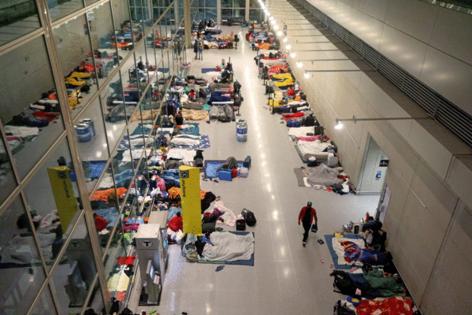Massachusetts Gov. Maura Healey received written warning about surge of migrants in transition document
Published in News & Features
BOSTON — Gov. Charlie Baker’s administration offered a written warning to Gov. Maura Healey about a surge of migrants and dwindling state shelter capacity in November 2022, or months before she took office, according to a transition document approved by Republican gubernatorial candidate Mike Kennealy when he was secretary of housing and economic development.
The heads-up largely focused on the need to expand shelter capacity and provide more funding to the emergency assistance program. It also painted a bleak picture of a struggle to build enough housing as the cost of living was putting Massachusetts at a “significant disadvantage.”
The document — which was obtained by the Herald after the Healey administration refused to release it through a public records request and subsequent appeal — said the number of families in emergency assistance shelter had been “increasing steadily” since September 2021.
“However, more recently, starting in June 2022, there was a significant surge in new asylum-seekers, refugees, and immigrants seeking EA shelter, many of whom have presented as in need of assistance at Boston Medical Center,” the document said.
In a Nov. 9, 2022 memo included in the transition document, former Housing and Community Development undersecretary Jennifer Maddox said the increase in emergency shelter demand was an “issue caused by national and international factors that are outside agency control.”
“Additional funding may be necessary to support efforts to expand emergency assistance shelter capacity,” Maddox said in the memo.
The inclusion of the burgeoning shelter crisis in the document, Kennealy’s claim that he personally warned Healey during a meeting that same month, and a December 2022 public letter to state lawmakers on the topic show the governor had ample notice when she took office about an issue that would dominate the first half of her four-year term.
Other than acknowledging that the shelter system was nearly at capacity at the end of Baker’s term, Kennealy and Maddox offered no major recommendations to further prepare Massachusetts for a sharp spike in demand that would follow months into Healey’s first year.
But Ed Augustus, Healey’s housing secretary, argued earlier this year that few people could have predicted the “once in a lifetime surge in shelter demand” that would ultimately see roughly 7,600 homeless families housed in a network of emergency shelters across the state.
“(The administration) strongly rejects the suggestion that it should have foreseen what was, in fact, a historically unprecedented increase in demand for emergency assistance shelter services driven by international and national forces far beyond EOHLC’s control,” Augustus said in a letter responding to Auditor Diana DiZoglio’s audit of the shelter system.
Karissa Hand, a spokesperson for Healey, said the governor “inherited a disaster of a shelter system” from Kennealy, whose “only recommendations were to increase spending and increase the use of hotels.”
“Gov. Healey is the one who took action to implement a length of stay limit, mandate criminal background checks, require residents to prove Massachusetts residency and lawful immigration status, and get families out of hotels,” Hand said in a statement to the Herald Monday afternoon.
Logan Trupiano, a spokesperson for Kennealy’s 2026 campaign for governor, said the Lexington native made clear during a transition meeting with Healey and Lt. Gov. Kim Driscoll “that the right-to-shelter law needed to be addressed.”
“At the time, Democratic leaders in the Legislature informed the Baker administration that they had no interest in working on the issue, and would only engage with the incoming administration,” Trupiano said in a statement to the Herald.
Baker unsuccessfully tried to persuade Beacon Hill Democrats to approve a spending bill with millions in extra funding for the state-run shelter system amid a surge of families arriving in Massachusetts from Afghanistan, Haiti, Venezuela, and Ukraine.
Lawmakers never advanced the bill in the final days of the 2021-2022 legislative term. But months later, legislative leaders approved a similar spending bill from Healey that included $130 million for the shelter program.
Healey received advance notice of a growing shelter crisis
Healey declared a state of emergency because of a lack of shelter space and influx of migrants on Aug. 8, 2023, or roughly a year after Maddox offered one of the first alerts to the incoming Democratic governor and months after approving additional funds for the shelter system.
Maddox said the emergency assistance family shelter system, which was created under a 1980s law to house homeless families with children and pregnant women, was already at less than 1% vacancy as of November 2022.
“Given these recent trends, (the Department of Housing and Community Development) has had to turn to temporary hotel shelter sites over the past few weeks to ensure the state can shelter eligible families,” Maddox said. “Efforts are underway across state agencies to bring on additional shelter capacity through the use of vacant state assets and other underutilized properties.”
The decision to use hotels and motels as temporary shelter sites would prove costly for Massachusetts taxpayers.
Housing families in state-funded hotel and motel shelters could often run hundreds of dollars a night, according to state contracts, and the Healey administration loaded millions onto taxpayer-funded credit cards to quickly purchase hotel rooms for homeless families.
Healey announced the end to the state of emergency last week and that the final hotel shelter in the state had closed.
Over the roughly two-year period, the governor and Beacon Hill Democrats approved restrictive policies that barred large groups of people from accessing state shelters in an attempt to bring down costs amid high demand.
But her administration spent $894 million on the emergency assistance program in fiscal year 2024 and another $940 million in fiscal year 2025, though the final tab for the last fiscal year is still expected to increase by tens of millions.
Housing shortage, underinvestment
Kennealy and Maddox also offered a now-familiar take on Massachusetts’ housing and rental market in the transition document — rental vacancy rates were low, housing production was stalling out, and the cost of living in the state was steadily growing.
“Talent is now more mobile than ever and the cost of living is a significant disadvantage as Massachusetts competes with peer states,” Kennealy wrote in the first pages of the document. “Home values and rents are among the highest in the country; inadequate production has contributed to estimated shortage of up to 200,000 units; and other major metro areas are permitting a lot more housing than Massachusetts.”
Maddox said state-aided public housing units built 40 to 70 years ago were aging after years of underinvestment and had “significant capital needs.”
“Additional funds and or/procurement relief will be necessary over the next two decades in order to preserve this unique asset of 43,270 permanently affordable, state-aided public housing units, which house a significant portion of the Commonwealth’s (extremely low income) population,” Maddox wrote.
The Baker administration said Healey had several key decisions to make in her first year, including whether to allocate cash for the preservation and “repositioning” of state-aided public housing and find a way to boost overall housing production in the state.
The first-term Democrat did shepherd a $5.2 billion borrowing bill to passage last year that she argued is the state’s most “ambitious” attempt to beat back crushing housing costs and boost accessibility for residents across the state.
That bill also included $2 billion in authorizations to make improvements at state-aided public housing, including $150 million to decarbonize public housing and $15 million for “accessibility upgrades.”
The Healey administration budgeted $157 million in fiscal year 2025 for improvements.
Document under wraps
Top officials at Healey’s Executive Office of Economic Development acknowledged they had the transition document but declined to provide a copy in response to a Herald public records request.
Robert McGovern, a records access officer at the agency, said the memo contained detailed analysis, opinions, and recommendations related to “numerous policy matters” confronting the various officers under Kennealy’s supervision.
The document, McGovern argued, helped “facilitate the transition of power of the highest elected office of the Commonwealth and inform decision-makers from the incoming Healey administration of various ongoing policy matters that they would face upon taking office.”
“It is a high-level strategic planning document designed to provide advice about how to best utilize time and resources over the course of an administration and to inform future policy decisions,” McGovern said to the Secretary of State’s Office in response to an appeal from the Herald to gain access to the document.
McGovern also said that “as far as we are aware, no gubernatorial administration in Massachusetts has ever before treated this kind of transition memo from its predecessors as subject to disclosure under the Public Records Law.”
“To ensure that each outgoing administration offers that level of cooperation and candor, and to promote the public interest in a smooth transition of power, this kind of transition memorandum should not be disclosed,” McGovern said.
-----------------
©2025 MediaNews Group, Inc. Visit at bostonherald.com. Distributed by Tribune Content Agency, LLC.







Comments